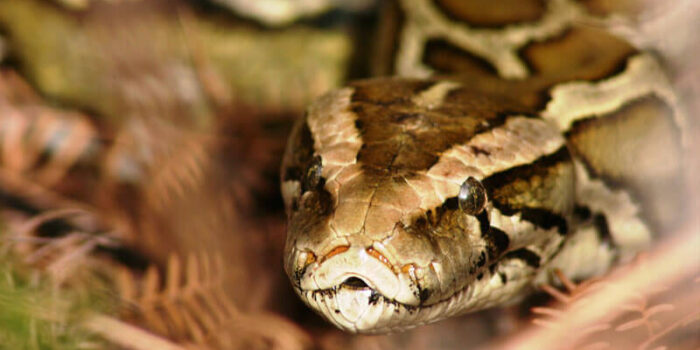Snakes are the most dangerous and deadly creatures in the world. The majority of people are very much impressed with these reptiles and the reason behind that is their striking colors and curious way of moving. This vicious and poisonous animal is also a major part of the culture of different societies. According to the reports these reptiles are the most popular animals studied by science.
Many types of research are done on the topic largest snakes. Different shows are also made where people with their whole crew go to the different forests to find the largest snake in that area. Thousands of snake species exist on this planet and every one has its own characteristics. But the question arises which is the largest snake in the world?? So to end this discussion we present you with an article based on the most authenticated and complete information. Following is the list of the top 20 largest snakes in the world.
20. Mangrove Snake

The Mangrove Snake, also known as the Gold-ringed Cat Snake, is found in Southeast Asia, primarily in mangrove swamps. Although not as massive as some of the other snakes on this list, it can reach lengths of up to 3 meters (9.8 ft). Known for its striking coloration, featuring vibrant red or orange rings against a black background, the Mangrove Snake is mildly venomous. It preys on small mammals, birds, and reptiles, utilizing its potent venom to incapacitate its prey. This snake’s alluring appearance contributes to its allure in the world of reptile enthusiasts.
19. Madagascarophis colubrinus

This snake, commonly known as the Madagascarophis colubrinus, hails from Madagascar. It’s a large non-venomous snake, reaching lengths of around 3.7 meters (12.1 ft). It’s recognized for its slender build and is typically found in various habitats, including forests, grasslands, and rocky areas. The Madagascarophis colubrinus is an adept climber, often observed in trees searching for prey like birds and small mammals. Its habitat versatility and climbing skills make it a fascinating subject for researchers studying snake behavior.
Read More: Top 20 Most Beautiful Snakes in the World
18. Woma Python

The Woma Python is native to Australia and is a non-venomous species belonging to the Pythonidae family. Known scientifically as Aspidites ramsayi, it can grow up to 3 meters (9.8 ft) in length. Recognizable by its distinctive head markings, the Woma Python prefers arid regions, such as deserts and scrublands. It primarily feeds on small mammals and possesses a unique ability to burrow into sandy soils. The Woma Python’s burrowing behavior showcases its remarkable adaptations to its arid environment.
Read More: 10 Non-Venomous Snakes
17. Brazilian Rainbow Boa

Found in the rainforests of South America, the Brazilian Rainbow Boa (Epicrates cenchria) is a visually stunning snake with iridescent scales. It can reach lengths of up to 1.8 meters (5.9 ft). Although not one of the longest, its vibrant appearance and distinctive iridescence make it a sought-after species in the exotic pet trade. The Brazilian Rainbow Boa is nocturnal and preys on small mammals, birds, and amphibians. Its popularity in the pet trade highlights the fascination people have with its unique coloration.
Read more: 10 Deadly Animals In Australia
16. Central American Bushmaster

The Central American Bushmaster (Lachesis stenophrys) is a venomous snake native to Central America. It can grow up to 3 meters (9.8 ft) in length and is characterized by its potent hemotoxic venom. This species inhabits various ecosystems, including tropical rainforests and lowland areas. Despite its venomous nature, the Central American Bushmaster is generally elusive and avoids human encounters. The snake’s elusiveness contributes to the mystique surrounding this venomous species.
Read More: Top 10 cruelest animals in the world
15. King Cobra

The King Cobra (Ophiophagus hannah) is the world’s longest venomous snake, capable of reaching lengths of over 5.5 meters (18.04 ft). Native to the forests of Southeast Asia, the King Cobra is known for its distinctive hood and potent neurotoxic venom. Despite its fearsome reputation, the King Cobra is a shy and reclusive snake, preferring to avoid confrontations with humans. The King Cobra’s preference for solitude contrasts with its intimidating appearance.
Read More: Top 10 Most Aggressive Animals In The World
14. Gaboon Viper

While not a snake known for its length, the Gaboon Viper (Bitis gabonica) is recognized for having the longest fangs of any snake. Native to the rainforests and savannas of sub-Saharan Africa, it can reach lengths of around 1.8 meters (5.9 ft). The Gaboon Viper has a distinctive triangular-shaped head and a unique camouflage pattern, making it highly effective at ambushing prey. The extraordinary length of its fangs contributes to its effectiveness as an ambush predator.
Read More: 10 Most Dangerous Animals in Africa
13. Indigo Snake

The Eastern Indigo Snake (Drymarchon couperi) is a non-venomous constrictor native to the southeastern United States. It can attain lengths of over 2.4 meters (7.9 ft). Known for its glossy indigo-blue coloration, it is the longest snake species in North America. This powerful snake primarily preys on small mammals, reptiles, and amphibians and is considered a keystone species in its ecosystem. The Indigo Snake’s role as a keystone species underscores its significance in maintaining ecological balance.
Read More: Top 10 Most Dangerous Animals in Australia
12. Cape Cobra

The Cape Cobra (Naja nivea), native to southern Africa, is a venomous snake that can reach lengths of around 1.2 meters (3.9 ft). Recognized for its smooth scales and various color variations, including yellow, brown, and black, the Cape Cobra is highly adaptable and can be found in diverse habitats, from arid regions to grasslands. Its venom is potent, primarily neurotoxic, making it a formidable predator. The Cape Cobra’s adaptability across various habitats reflects its success as a widespread and formidable species.
11. Mexican Black Kingsnake

Native to the southwestern United States and Mexico, the Mexican Black Kingsnake (Lampropeltis getula nigrita) is a non-venomous serpent. While not one of the largest snakes, it can grow up to 1.5 meters (4.9 ft). Its sleek black coloration and glossy scales make it a popular choice in the pet trade. The Mexican Black Kingsnake is known for its constricting behavior and diet, which includes rodents, reptiles, and other small animals. The snake’s popularity in the pet trade is attributed to its captivating appearance and manageable size.
10. Reticulated python
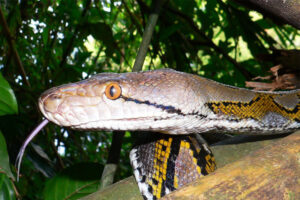
Reticulated Python is mostly found in South Asia is up to 18 ft. long and has a weight of 133.7 kg. These bulky pythons can be very dangerous because they can prey on humans. They usually live in rivers, rainforests, and the area near streams lakes, and woodlands. They have a tag of the world’s largest snake but the most amazing thing is that they are excellent swimmers too. Reticulated python mostly eats mammals birds, rats etc.
9. Green Anaconda
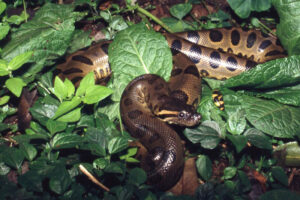
Green Anaconda is also on the list of the largest snakes in the world. They are non-venomous boa species mostly found in South Africa. The green anaconda is also known as a water boa and is basically a non-venomous. This heavy snake belongs to the Boidae family and is one of the largest snakes in the world and is 5.21m (18.1 ft.) long.
8. Burmese Python
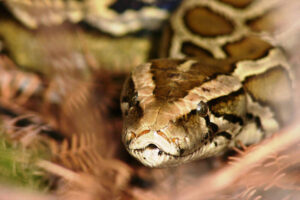
A Burmese python is 12.1 Ft long and is mostly found near water and sometimes on trees as well. It belongs to the Pythonidae family and has a dark color with huge brown blotches bordered in black down the back.
7. African rock python
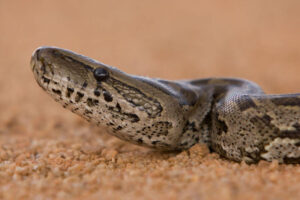
African Rock Python is present in Africa and made its name in the list of largest snakes in the world. They can easily exceed up to 6m and live near deserts, forests, and water.
6. Amethystine python
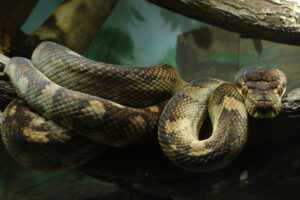
Amethystine Python is also famous for the name scrub python or sanca Permata. Amethystine python is native to Australia and Indonesia and is non-venomous. It can reach up to 5m (16.4 Ft) and the weight of females are around 15 kg. The weight of males is around 5.1 kg at the time they are mature but they can reach up to 11 kg. But males are mostly slimmer than females. They are present in rainforests and humid habitats.
5. Yellow Anaconda
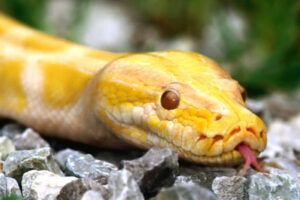
Yellow Anaconda belongs to the Boidae family and is also known as Paraguayan Anaconda. It is smaller than a green anaconda and like all boas and pythons, it is also a non-venomous snake. Yellow anaconda kills its prey by constriction.
4. Indian Python
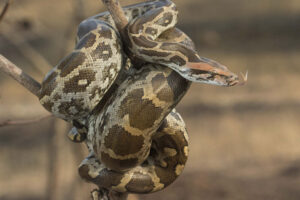
Forests of India are full of these heavy Pythons and can easily reach up to 15 Ft. They are generally found in grasslands, banks around the river, trees, and streams and have a weight of up to 91 kg.
3. Dark-spotted anaconda
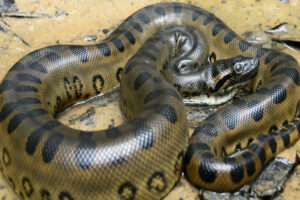
They are mostly spotted in tropical regions and can be 14.8 Ft long and weigh up to 3o kg. They usually eat mammals, lizards, bats, amphibians, mice, and birds. They can also be dangerous for humans as well.
2. Boa constrictor
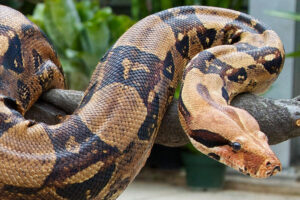
Boa constrictor is also famous for the name of red-tailed boa. This bulky and non-venomous snake can weigh up to 27 kg and can reach up to 13 Ft. They are mostly found in tropical North, South, and Central America.
1. Papuan Python (# 1 in the List of Largest Snakes)
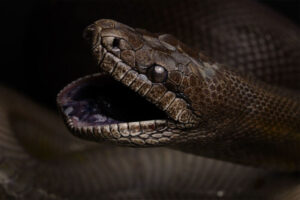
Papuan Python is number 1 in the list of largest snakes in the world having a weight of 25.5 kg. They can easily reach up to 14.4 Ft. Females are larger than males and mostly live in grasslands, rainforests, and streams. They are excellent swimmers and that is the reason they are commonly found in rivers.
